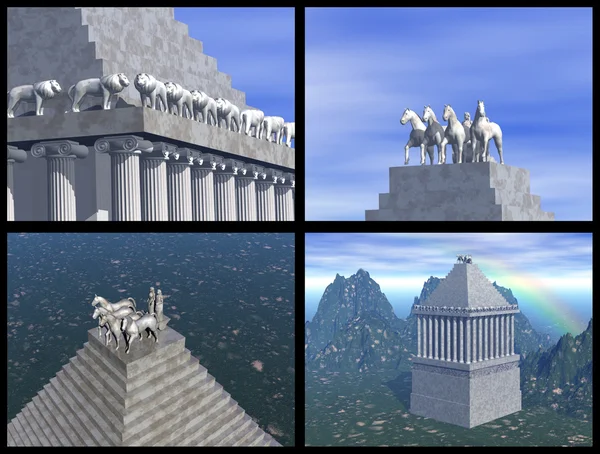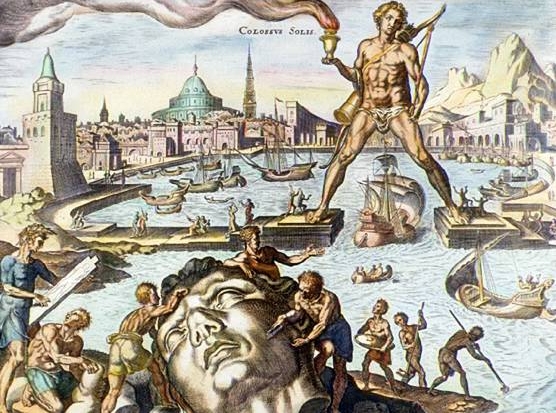Popular Posts
-
The Seven Wonders of the World, as most people know them, are technically the Seven Wonders of the Ancient World, man-made structures that ...
Blogger templates
Blogger news
Blogroll
About
mercredi 3 avril 2013
The Seven Wonders of the World, as most people know them, are technically the Seven Wonders of the Ancient World, man-made structures that were built during the classical era. There are lists of ancient wonders as far back as the second century B.C., but the current list was defined in the Middle Ages.
The Great Pyramid at Giza
The Great Pyramid is the only surviving an
cient wonder and was built in the ancient city of Giza, now part of Cairo, Egypt. The pyramid took anywhere from 14,000 to 360,000 men approximately 20 years to build and is estimated to have been constructed in 2650 B.C. as a tomb for Egyptian Pharaoh Khufu. The pyramid is 480 feet high and remained the world's tallest building for 4,000 years.
The Hanging Gardens in Al-Hillah, Iraq, (formerly Babylon) are often disputed because there is no physical evidence of the gardens. Greek scholars first mention the gardens, but Babylonian documents don't record the gardens' existence. The Hanging Gardens are believed to have been built by Nebuchadnezzar II in 600 B.C. in a rising form and had a complicated irrigation system, hence the reason for the wonder. It is believed that an earthquake destroyed the gardens in the first century B.C.

The Statue of Zeus was built near 450 B.C. in Olympia, Greece, and was 40 feet tall. The statue was designed by Greek sculptor Pheidias and depicted the god on a cedar throne inlaid with jewels. He held a scepter in his left hand and a statue of Nike (the goddess of victory) in his right. It was made out of ivory with gold-plated accents. Some believe it was destroyed in the fifth century, other scholars say it was taken to Constantinople, then burned in a fire in A.D. 462.

Selcuk, Turkey, was the home of the temple built in 550 B.C. to honor the Greek goddess of nature and hunting. The building was about three times the size of the Parthenon and made of marble. The temple was used as a place of worship and a marketplace. The Temple of Artemis was destroyed by arson in 356 B.C.

The tomb was built in Turkey for Persian king Mausollos and his wife, Artemisia. Designed by Greek architects Satyrus and Pythius, the tomb was built in 353 B.C. on a hill that overlooked Halicarnassus. The tomb was 135 feet high and was ornately decorated. The term "mausoleum," meaning a large and impressive tomb, was derived from this tomb. Earthquakes destroyed the tomb in the 14th century.


thanks for reading :)
The Hanging Gardens of Babylon
The Hanging Gardens in Al-Hillah, Iraq, (formerly Babylon) are often disputed because there is no physical evidence of the gardens. Greek scholars first mention the gardens, but Babylonian documents don't record the gardens' existence. The Hanging Gardens are believed to have been built by Nebuchadnezzar II in 600 B.C. in a rising form and had a complicated irrigation system, hence the reason for the wonder. It is believed that an earthquake destroyed the gardens in the first century B.C.

The Statue of Zeus was built near 450 B.C. in Olympia, Greece, and was 40 feet tall. The statue was designed by Greek sculptor Pheidias and depicted the god on a cedar throne inlaid with jewels. He held a scepter in his left hand and a statue of Nike (the goddess of victory) in his right. It was made out of ivory with gold-plated accents. Some believe it was destroyed in the fifth century, other scholars say it was taken to Constantinople, then burned in a fire in A.D. 462.
The Temple of Artemis at Ephesus

Selcuk, Turkey, was the home of the temple built in 550 B.C. to honor the Greek goddess of nature and hunting. The building was about three times the size of the Parthenon and made of marble. The temple was used as a place of worship and a marketplace. The Temple of Artemis was destroyed by arson in 356 B.C.
Tomb of Maussollos at Halicarnassus

The tomb was built in Turkey for Persian king Mausollos and his wife, Artemisia. Designed by Greek architects Satyrus and Pythius, the tomb was built in 353 B.C. on a hill that overlooked Halicarnassus. The tomb was 135 feet high and was ornately decorated. The term "mausoleum," meaning a large and impressive tomb, was derived from this tomb. Earthquakes destroyed the tomb in the 14th century.
The Colossus of Rhodes

- The Colossus was a 100-foot-tall statue of the Greek god Helios and was built on the island of Rhodes in 280 B.C. The island defended itself from an invasion in 304 B.C. and the statue was built in honor of the island's patron god. The statue is believed to have stood at the island's harbor. The Colossus was destroyed by an earthquake in 226 B.C.
The Lighthouse of Alexandria
- The Lighthouse of Alexandria was designed in the third century B.C. as a landmark for Pharos, an island off the coast of Egypt. The tower was 383 to 450 feet high with light-colored stone. At the top, a mirror was set to reflect sunlight, while a fire burned at night. Historical documents say the light could be seen for 35 miles. In 1303 and 1323 the lighthouse was damaged by earthquakes, then fully destroyed in 1480 as a fort was built on the island.
thanks for reading :)
Inscription à :
Publier les commentaires (Atom)



0 commentaires:
Enregistrer un commentaire